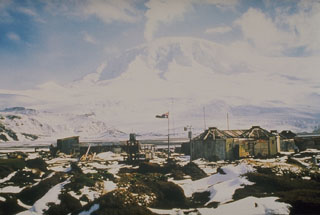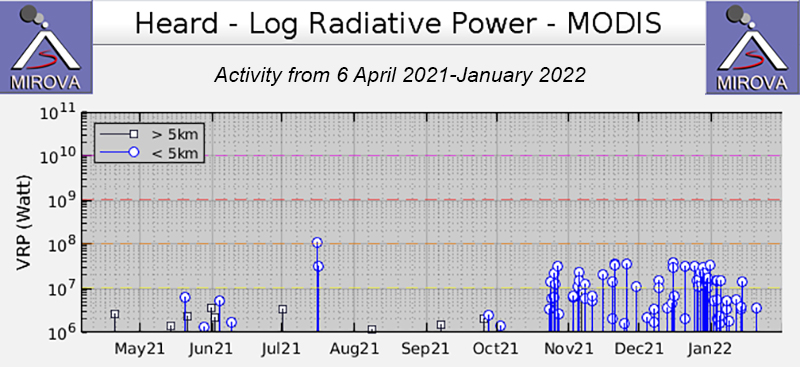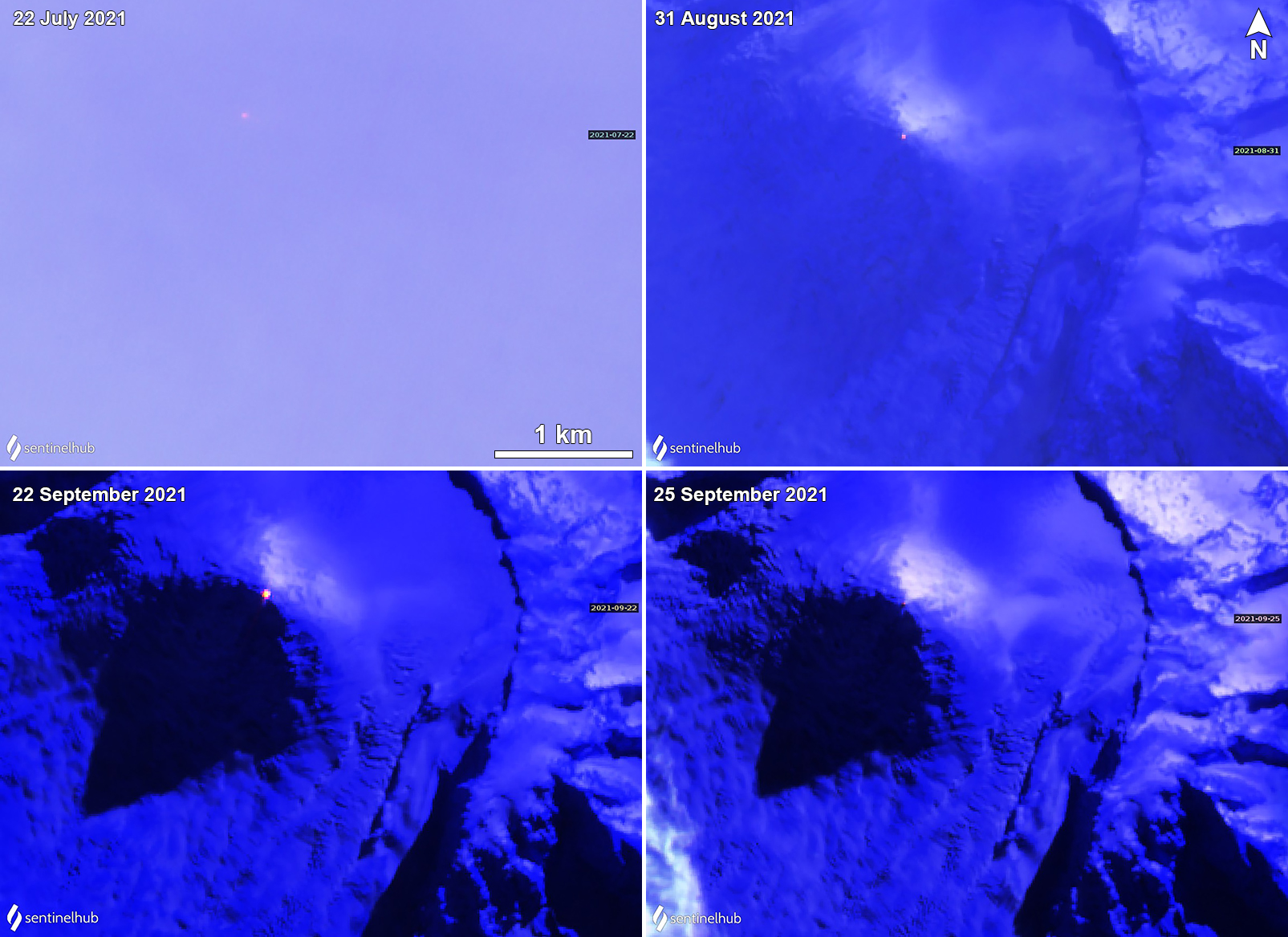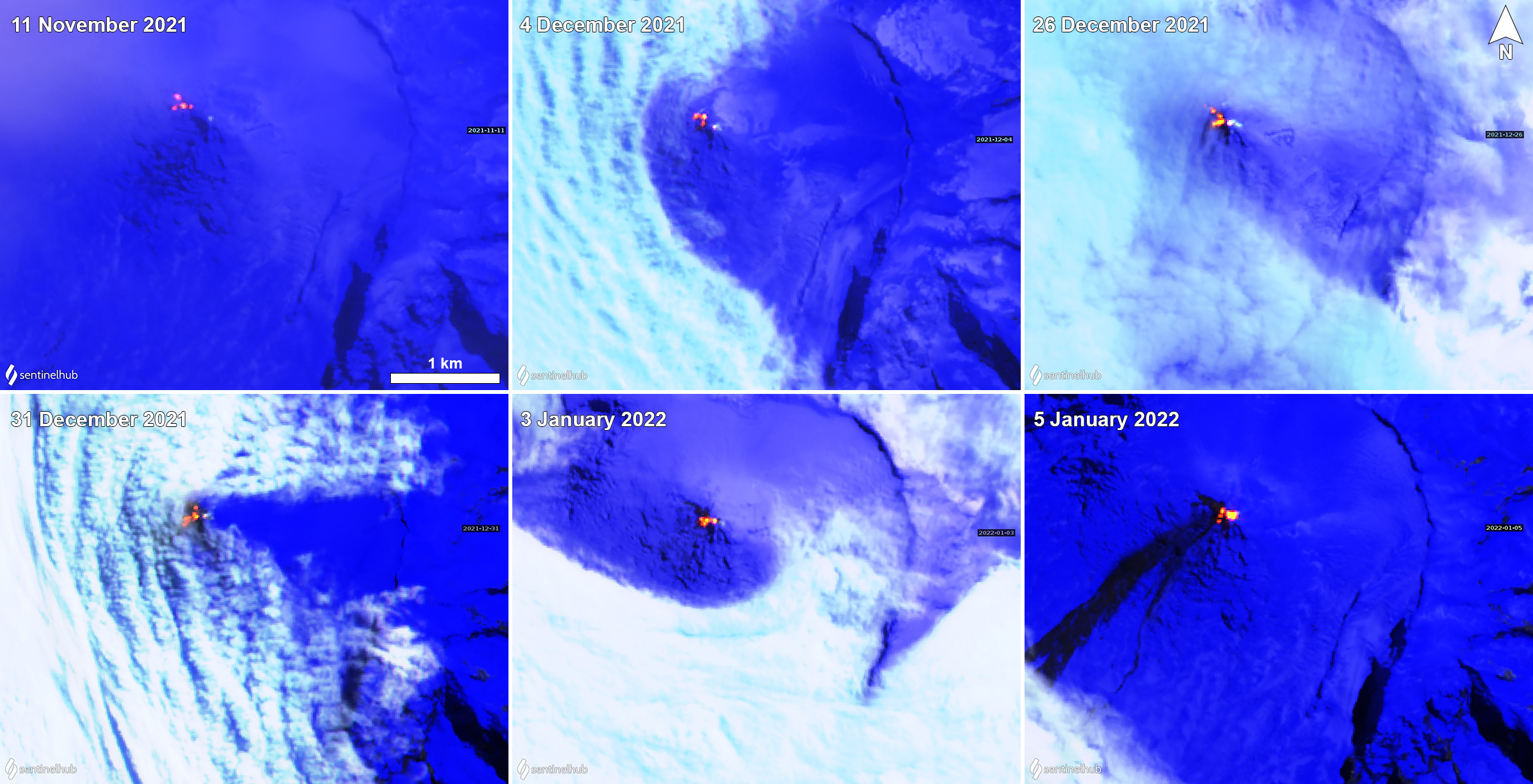Report on Heard (Australia) — February 2022
Bulletin of the Global Volcanism Network, vol. 47, no. 2 (February 2022)
Managing Editor: Edward Venzke.
Edited by Kadie L. Bennis.
Heard (Australia) Thermal anomalies and lava flows continue; strong lava flow event during 3-5 January 2022
Please cite this report as:
Global Volcanism Program, 2022. Report on Heard (Australia) (Bennis, K.L., and Venzke, E., eds.). Bulletin of the Global Volcanism Network, 47:2. Smithsonian Institution. https://doi.org/10.5479/si.GVP.BGVN202202-234010
Heard
Australia
53.106°S, 73.513°E; summit elev. 2745 m
All times are local (unless otherwise noted)
The remote island of Heard is located in the southern Indian Ocean and contains the Big Ben stratovolcano, which has been intermittently active since 1910. Activity during late November 2020 through January 2021 produced thermal anomalies over the active Mawson Peak and lava flows (BGVN 46:05), which is similar to activity during this reporting period of February 2021 through January 2022. Information primarily comes from satellite data.
MIROVA (Middle InfraRed Observation of Volcanic Activity) analysis of MODIS satellite data shows that the thermal activity was relatively low during February through September 2021, with the exception of four low-power anomalies between late May and early June and two stronger anomalies in mid-July (figure 48). Despite the cloudy weather, Sentinel-2 infrared satellite imagery also detected the stronger anomaly at Mawson Peak on 22 July (figure 49). Very weak anomalies were also visible in satellite imagery on 31 August and 22 and 25 September, though they remained stationary and close to the summit (figure 49).
Renewed thermal activity of varying intensities was detected in Sentinel-2 infrared satellite imagery over the summit area and on the NW and W flanks on 4, 11, 14, and 21 November, though weather clouds often prevented clear views of the summit. On 11 November four anomalies just NW of Mawson Peak formed a “v” shape open to the NW, which could indicate a branched lava flow; this increase in thermal activity was also noted in MIROVA data (figure 50). According to the MODVOLC Thermal Algorithm, there was a total of twelve thermal alerts on 15, 20, and 25 November and 15, 24, and 28 December. A strong anomaly was visible on the W flank on 21 November, accompanied by possible gas-and-steam emissions that extended E and SE.
Anomalies continued to be detected through January 2022. A possible lava flow was observed on 4 December on the NW flank, accompanied by gas-and-steam emissions to the SE. A strong gas-and-steam plume occurred on 16 December, extending NE and accompanied by a lava flow. A small possible branched lava flow was visible traveling NW and SW on 26 December, accompanied by a small gas-and-steam emission to the E. This activity was also visible on 31 December. Sometime during 3 and 5 January, a strong lava flow event occurred, descending the SW flank, based on satellite images (figure 50). Clouds obscured views of the summit during a majority of the month, though a small anomaly and gas-and-steam emission drifting N were detected on 20 January. A weaker anomaly was visible on the NW flank on 30 January.
Geological Summary. Heard Island on the Kerguelen Plateau in the southern Indian Ocean consists primarily of the emergent portion of two volcanic structures. The large glacier-covered composite basaltic-to-trachytic cone of Big Ben comprises most of the island, and the smaller Mt. Dixon lies at the NW tip of the island across a narrow isthmus. Little is known about the structure of Big Ben because of its extensive ice cover. The active Mawson Peak forms the island's high point and lies within a 5-6 km wide caldera breached to the SW side of Big Ben. Small satellitic scoria cones are mostly located on the northern coast. Several subglacial eruptions have been reported at this isolated volcano, but observations are infrequent and additional activity may have occurred.
Information Contacts: MIROVA (Middle InfraRed Observation of Volcanic Activity), a collaborative project between the Universities of Turin and Florence (Italy) supported by the Centre for Volcanic Risk of the Italian Civil Protection Department (URL: http://www.mirovaweb.it/); Hawai'i Institute of Geophysics and Planetology (HIGP) - MODVOLC Thermal Alerts System, School of Ocean and Earth Science and Technology (SOEST), Univ. of Hawai'i, 2525 Correa Road, Honolulu, HI 96822, USA (URL: http://modis.higp.hawaii.edu/); Sentinel Hub Playground (URL: https://www.sentinel-hub.com/explore/sentinel-playground).




